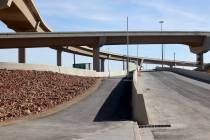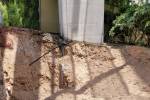Cone zone workers see motorists at their worst
Mary Ann Robb is bubbly, friendly and super polite -- a typical Minnesotan.
It's difficult to imagine a Las Vegas cabby would grow so frustrated he would spit on her face, but that is what tends to happen at Robb's job site. Motorists irritated by construction barriers become impatient when they encounter workers protecting the cone zone.
"They don't like when you mess with their routine. They don't understand why they can't take the same route they've been taking for 20 years and it makes them angry," Robb said. "Everybody likes a nice road to drive on, but they don't like to see you working."
Robb doesn't run a traffic court, she's not a cop, nor is she a member of the Taxicab Authority. She recently invited me to her workplace -- on this evening, the intersection of Paradise and Desert Inn roads -- to get a taste of life as a flagger inside the cones.
Every motorist in this town is well aware of what it's like on the outside: congested and maddening. It is far more entertaining inside the zone.
As the clock approaches 9 p.m. Tuesday, rollers, massive trucks, front-loaders and a rotomiller belonging to Las Vegas Paving rumble then burst into a window-shaking roar. Workers quickly place tall orange cones along Paradise Road, squeezing the thoroughfare down to one lane on either side of Desert Inn.
Within minutes, the equipment rolls out from dark streets like a platoon of cockroaches declaring war on a half-eaten cookie. The street vibrates as a rotomiller chews up Paradise Road and chucks the tiny leftovers into an end-dump hauler. Front-loaders, one of the smallest vehicles in the fleet, zip around scraping trenches in preparation for the asphalt.
Predictably, it doesn't take long for traffic to pile up. You can feel the tension build.
Supervisor Matt Woofley, noticing the scraping and dumping has been replaced by reverberations, glances up to see a minivan inside the barricade, now stuck behind one of the asphalt haulers and a very unhappy crew member. Did he not see the cones?
"The barricades are just a suggestion to some of these people," he says, sort of surprised but mostly not. "In a minute there will be another car behind that one."
Sure enough. Off goes Robb to guide them out.
Then it's a bicyclist who hatches a brilliant idea to wait for traffic to clear along Paradise on a median in the middle of the construction zone and only feet away from where the rotomiller is bearing down. Robb makes a break for the guy and calmly says something that prompts him to move. It must have been something along the lines of the rotomiller's capabilities of squashing him like a grape.
Next a motorist pulls midway into the intersection, practically parking on a flagger's boot. Uh, hello?
Another flies through the intersection going 50 mph, oblivious to the ditch cut by the rotomiller and the flagger holding up the "slow" sign. You have to hope their tires aren't too expensive. Kind of.
Most flaggers are women, but that is not necessarily because companies that land government contracts are required to hire a certain number of minority workers. For four decades Robb, for example, has worked all sorts of jobs in construction field. Flagging is her favorite.
"I like being outside. Men don't like it," she said. "They think it's boring."
"Women are more patient, I think that's the reason," Woofley offered.
That makes sense because patience is key to the other hand. On the other hand I would have clocked somebody by now.
"Unfortunately they get verbally abused more because they are women. They get numb to it, they get used to it but they shouldn't have to," Woofley said. "If these drivers see a 6-foot, 250-pound guy (flagging), I think they might think twice about saying something because they know the outcome."
■ ■ ■
These crews are passionate about their craft.
"It's like a baker who bakes the perfect cake," Woofley said. "They admire their creation."
And we are passionate about the crews, but in more of a passionately-sick-of-them-and-their-cones kind of way.
So, while Woolfey was available, he addressed some of the issues that irk us, the inconvenienced public.
Government agencies swear they coordinate with utilities when they tear up a road and that newly paved streets are never immediately dug into again. Right.
Woofley is more honest.
"It happens way more than it should and it makes me sick to my stomach."
The day after Russell Road was paved behind McCarran International Airport, a utility company decided it needed another conduit underneath the road and gouged out a chunk of asphalt to install it. One day. Had the company told Woofley, he could have delayed the paving phase. Now each time he drives over that bump, his blood boils.
Another pet peeve: Why are there cones blocking lanes when nobody is seen working for days? The Paradise Road project, which is more than a year late, is a perfect example. Woofley said his crews are ready to roll at 9 every night, but change orders might cause a delay in the project's design and road work has to wait. Crews don't know when they will be called back to a job, so removing the cones is neither cost- or time-efficient.
■ ■ ■
Paving companies do not just make up work zones and put up pylons wherever they wish. All the traffic configurations or lane and road closures are first reviewed and approved by government engineers.
Seeing these crews at work makes one realize they truly are efficient. In an eight-hour shift, they gouged out two lanes of Paradise Road, each a mile long, filled them and repaved it. On Wednesday afternoon, it was smooth as can be.
Knowing that these workers are making our drive more pleasant doesn't necessarily make motorists' behavior more pleasant. After years on the job, Robb remains a typical Minnesotan, but one more spit in the face could change all that.
If you have a question, tip or tirade, call Adrienne Packer at 702-387-2904, or send an email to roadwarrior@reviewjournal .com. Please include your phone number.
GASOLINE PRICES
The average price of gasoline in the Las Vegas Valley on Friday was $3.72 per gallon; the current state average is $3.76; the national average is $3.79. Find the Las Vegas Valley's best deals at gasbuddy.com.
• From 7 to 11 a.m. today, crews will be repairing potholes on the Summerlin Parkway offramps at Anasazi Drive and Town Center Drive.
• From 9 tonight to 5 a.m. Monday, the ramp from westbound Interstate 215 to Interstate 15 south will be closed.
• From 9 tonight to 5 a.m. Monday, the ramp from eastbound I-215 to I-15 south will be closed.
• Gilcrease Avenue, between Fort Apache and Oso Blanca roads, will be closed starting Monday through June 24.
• Monday through Friday, Stephanie Street will be closed between American Pacific and Wigwam Parkway.
• Through June 17, the left lane will be closed in each direction of Las Vegas Boulevard between Flamingo and Russell roads between the hours of 2 a.m. and 10 a.m.
Las Vegas Review-Journal























